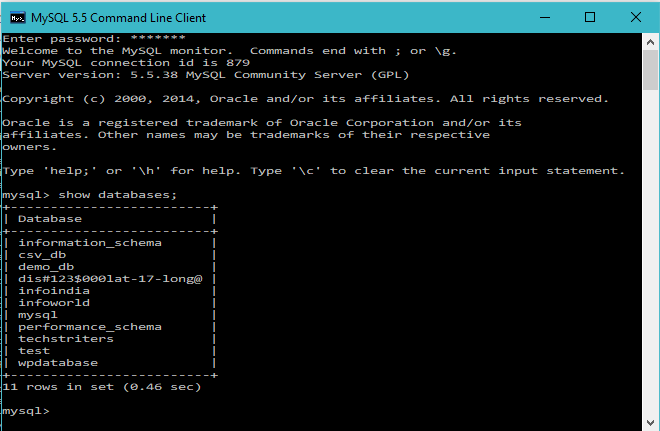
- INSTALL ADDITIONAL MYSQL DATABASE SERVER WEBMIN HOW TO
- INSTALL ADDITIONAL MYSQL DATABASE SERVER WEBMIN INSTALL
- INSTALL ADDITIONAL MYSQL DATABASE SERVER WEBMIN PASSWORD
Importing this file to a new database will import all your posts, pages, comments and your login info to new database. When you export an MySQL database with phpMyAdmin or another software, it creates a file with all those information with.
INSTALL ADDITIONAL MYSQL DATABASE SERVER WEBMIN PASSWORD
What is a SQL Dump file?Īll your posts, pages, comments, email address you use to login to your website and even your password is stored in a MySQL database.
INSTALL ADDITIONAL MYSQL DATABASE SERVER WEBMIN HOW TO
You can find the video how to at end of the page.

If your new server is built with Virtualmin or you used my Virtualmin and Nginx on an unmanaged VPS tutorial, you can use this method to import your database backup file into MySQL database. In either way, you should migrate your files and databases over to the new server. Or migrating from managed VPS to unmanaged VPS to cut the cost. You might be migrating from shared hosting to a VPS that has Virtualmin installed.
INSTALL ADDITIONAL MYSQL DATABASE SERVER WEBMIN INSTALL
This means that you don’t have to install phpMyAdmin on your server just to import an MySQL backup file into a database.ĭownloading the SQL dump file and importing it to the new server is an important part in server migration. It gives you an option to import SQL dump file (Database backup file) into MySQL database directly from its MySQL module. You should now see the “Apache Webserver”, “PostgreSQL Database Server” and “MySQL Database Server” listed in the “Servers” tab.Virtualmin is a feature rich control panel to manage your VPS. Hba_conf=/opt/bitnami/postgresql/data/pg_hba.confīrowse to the Webmin application, log in and click the “Refresh Modules” button.

Rstr_cmd=/opt/bitnami/postgresql/bin/pg_restore Stop_cmd=sudo /opt/bitnami/ctlscript.sh stop postgresql >/dev/null 2>&1ĭump_cmd=/opt/bitnami/postgresql/bin/pg_dump Similarly, create the configuration file /etc/webmin/postgresql/config for PostgreSQL (if you have it installed) and fill it with the content below: start_cmd=sudo /opt/bitnami/ctlscript.sh start postgresql >/dev/null 2>&1 Srm_conf=/opt/bitnami/apache/conf/srm.conf Virt_file=/opt/bitnami/apache/conf/vhosts Mime_types=/opt/bitnami/apache/conf/mime.typesĪccess_conf=/opt/bitnami/apache/conf/nf Httpd_conf=/opt/bitnami/apache/conf/nfĪpachectl_path=/opt/bitnami/apache/bin/apachectlĪpply_cmd=/opt/bitnami/apache/bin/apachectl gracefulĭefines_file=/opt/bitnami/apache/bin/envvars Stop_cmd=sudo /opt/bitnami/ctlscript.sh stop apache >/dev/null 2>&1 Similarly, create the configuration file /etc/webmin/apache/config for Apache and fill it with the content below: start_cmd=sudo /opt/bitnami/ctlscript.sh start apache >/dev/null 2>&1 Mysqlshow=/opt/bitnami/mariadb/bin/mysqlshow Mysqlimport=/opt/bitnami/mariadb/bin/mysqlimport Mysqldump=/opt/bitnami/mariadb/bin/mysqldump Mysqladmin=/opt/bitnami/mariadb/bin/mysqladmin Stop_cmd=sudo /opt/bitnami/ctlscript.sh stop mariadb >/dev/null 2>&1 Mysqlshow=/opt/bitnami/mysql/bin/mysqlshowįor MariaDB, use the configuration below instead: start_cmd=sudo /opt/bitnami/ctlscript.sh start mariadb >/dev/null 2>&1 Mysqlimport=/opt/bitnami/mysql/bin/mysqlimport Mysqldump=/opt/bitnami/mysql/bin/mysqldump Mysqladmin=/opt/bitnami/mysql/bin/mysqladmin

Stop_cmd=sudo /opt/bitnami/ctlscript.sh stop mysql >/dev/null 2>&1 To configure Webmin to manage the Bitnami servers:Ĭreate the configuration file /etc/webmin/mysql/config for MySQL and fill it with the content below: start_cmd=sudo /opt/bitnami/ctlscript.sh start mysql >/dev/null 2>&1 NOTE: The steps below are only valid for Linux hosts.

Understand the default directory structure.Learn about the SSH warning 'REMOTE HOST IDENTIFICATION HAS CHANGED'.Configure password-based SSH authentication.Frequently Asked Questions for Virtual Machines


 0 kommentar(er)
0 kommentar(er)
